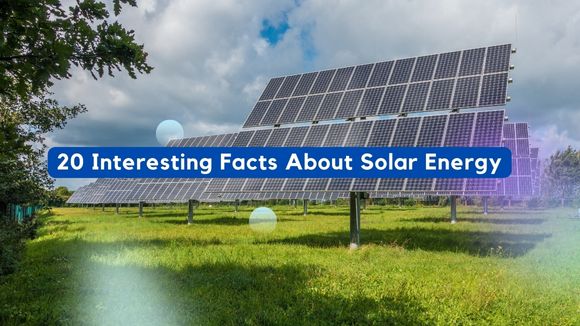Solar energy is a form of energy that is derived from the sun. It is one of the most renewable sources of energy available and can be used for a variety of purposes, including heating and cooling homes and businesses, generating electricity, and fueling vehicles.

Solar energy is a great choice for those looking to reduce their carbon footprint, as it doesn’t produce any emissions that contribute to climate change. Additionally, installing solar panels can help reduce your monthly energy costs, making solar a cost-effective option in addition to its environmental benefits.
Here are 20 interesting facts about solar energy that you may not know:
Interesting Facts About Solar Energy
The sun is our most abundant source of energy, and it is a renewable resource that can be used to generate electricity. Solar radiation striking the earth’s surface averages 174,000 terawatts, and this energy can be converted into electricity using photovoltaic cells.
Did you know that just one hour of sunlight contains enough energy to power the entire planet for a year? That’s pretty incredible when you think about it.
And it’s not just the amount of sunlight that’s important, but also the quality of the sunlight. The sun’s rays are full of ultraviolet (UV) radiation, which is absorbed by the atmosphere and converted into heat. This heat then drives the worldwide ocean currents and weather patterns that we rely on for our survival.
Solar energy is a clean and renewable resource that can be used to generate electricity with no pollution.
The Sun is about 150 million kilometers (93 million miles) away from Earth. That might not seem like much in the grand scheme of things, but it’s a pretty long journey for sunlight. It takes about 10 minutes for sunlight to travel 93 million miles from the Sun to the Earth.
The average solar power plant has a lifespan of around 40 years, and some plants have been in operation for over 50 years. With proper maintenance, solar power plants can continue to operate at full capacity for many years to come.
Solar electricity, or photovoltaics, is the direct conversion of sunlight into electricity. This technology has been around since 1839 when Alexandre Edmond Becquerel discovered the photovoltaic effect. Solar panels are made up of a series of solar cells, which use the photovoltaic effect to convert sunlight into electricity.
As the world continues to grapple with the issue of climate change, the need for renewable energy sources has never been greater. Solar power is one of the most promising renewable energy technologies, and China has emerged as a global leader in solar energy generation.
A Japanese company has announced plans to build solar power cells on the Moon, in a bid to provide clean energy to Earth. The company, which currently manufactures solar panels for use in space, says that the Moon is an ideal location for its proposed solar plant, as it receives twice as much sunlight as Earth.
In a city that is constantly pushing the envelope when it comes to architecture and engineering, it is no surprise that Dubai is now home to the world’s first completely solar-powered city. Set to be completed in the 2020s, the city will rely entirely on renewable energy sources, with a sustainable, zero-carbon, zero-waste ecology. The city will span 6 square kilometers and will include residential, commercial, and industrial areas.
Although solar panels are most commonly associated with generating power from direct sunlight, they can also produce power from indirect sunlight or diffused light. This means that even on cloudy days or in shaded areas, solar panels can still generate electricity. In addition, solar panels can also be used to generate electricity at night when there is no sunlight available. This makes solar panels a versatile and reliable source of renewable energy.
Solar panels have long been used to power small devices like calculators and road signs. More recently, solar panels are being used to power larger devices, like homes and businesses. As solar technology continues to improve, there is no reason why solar panels couldn’t be used to power airplanes. Solar panels could be used to supplement the power generated by the plane’s engines, or they could be used as the primary source of power.
Bell Laboratories developed the first silicon solar cell in 1954. The device was made from a thin wafer of crystalline silicon and was designed to convert sunlight into electricity. Today, silicon solar cells are the most popular type of solar cell, and they are used in a wide range of applications.
Believe it or not, the first solar-powered calculator was invented all way back in 1978. It represented a major breakthrough in solar technology. The calculator ran on a small solar panel, which converted sunlight into electrical energy. This energy was then used to power the calculator’s circuitry. It is the first device to use solar power.
If you’re looking for a way to save money on your energy bill and help the environment at the same time, solar power is a great option. And there’s no need to spend a fortune on solar panels – you can build your solar energy collector for well under $100, using scrap materials and basic tools. The open-source design for the solar collector is available online, and it can be built using nothing more than recycled aluminum cans, plywood, black paint, and a few other inexpensive materials.
The International Space Station is a truly remarkable feat of engineering. Not only is it the largest artificial structure in space, but it is also entirely solar-powered. The station is equipped with an array of solar panels that convert sunlight into electricity. This electricity is then used to power the station’s many systems and experiments. The solar panels are also capable of storing energy, which is essential for maintaining power during times when the sun is not visible, such as during an eclipse.
In the early 1500s, Leonardo da Vinci designed a solar power system that could have been used to generate electricity on a large scale. He proposed using a network of mirrors to reflect sunlight onto a central tower, where it would be used to heat water and create steam.
One of the many benefits of solar power is that it doesn’t create any noise while it’s generating electricity. This is in contrast to fossil fuel power plants, which often produce a significant amount of noise pollution.
Giacomo Luigi Ciamician is considered the father of solar energy. An Italian chemist and pioneer in the field of renewable energy, Ciamician devoted his career to finding new ways to harness the power of the sun. In 1912, he published a groundbreaking paper outlining the potential of solar energy to meet the world’s future energy needs. Ciamician was nominated for the Nobel Prize in Chemistry nine times, but he never won the prestigious award.
Some birdwatchers have raised alarm in recent years over the spread of solar energy farms. These massive installations often cover hundreds of acres, and their bright reflective surfaces can be deadly for birds. In particular, the farms can cause what is known as “solar glare,” which can disorient birds and cause them to crash into the mirrors. In some cases, the impact is so strong that the birds are ignited in mid-air. While this problem is not widespread, it has caused some environmentalists to call for stricter regulation of solar energy farms.





